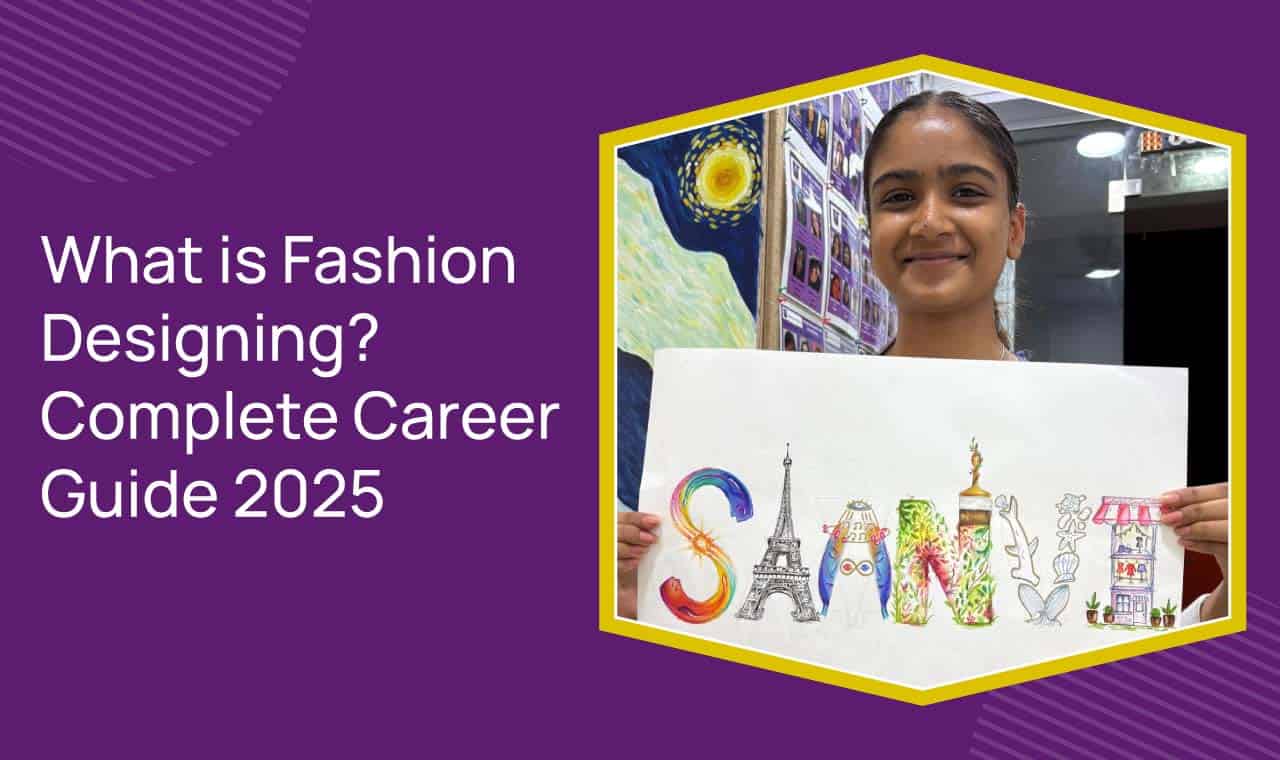
Fashion design is an artistic and competitive profession that is founded on originality, accuracy, and practicality. You are not merely sketching clothes; you are creating fashions, creating brands, and solving design challenges in fabric and shape.
The fashion industry in India is expanding rapidly. Local brands are going big. Multinational companies are recruiting. Digital design is transforming the means of production and marketing of clothing. When you consider becoming a fashion professional, along with skills, you must have a strategy.
This guide provides you with a full roadmap, including what fashion designing is, courses, eligibility, career options, and salaries to be expected in 2025.
Discover how to start your fashion journey today
What is Fashion Designing? Definition and Overview
Fashion design is the art of designing clothes and accessories, paying attention to design, utility, and customer requirements. It is where thoughts are turned into clothes.
As a fashion designer, you will draw ideas, select materials, liaise with suppliers, and be on top of trends. You influence the way people dress and the way they feel in what they wear.
You can specialise in areas such as
- Apparel design (casual, formal, couture)
- Textile design
- Jewellery and accessory design
- Footwear design
- Digital fashion (3D and virtual garments)
If you are looking to study affordably, consider applying to the top 10 government fashion design colleges in India, which offer excellent training at subsidised rates.
Fashion Designing vs. Fashion Styling:
Designing involves coming up with original pieces. Styling refers to putting together outfits with the help of existing garments. Both count, yet the essence of fashion begins with design.
To build a successful design career, you need skills in:
- Drawing and sketching
- Colour theory and fabrics
- Sewing and construction
- Trend analysis
- CAD software
In 2025, you can work in design studios, retail chains, or media houses, or run your own label. Fashion is a creative career with real business value.
Available Fashion Designing Courses After 12th
After successfully completing 12th grade, you have a variety of fashion design courses to choose from. This choice ought to depend on how much you want to learn about the topic and how soon you want to become part of the industry.
Here are the main fashion design course types:
-
Diploma in Fashion Design
This 1-2 year course inculcates the fundamental skills, such as pattern making, fabric analysis, and garment construction. It is a viable entry into the industry. Many students opt for a diploma in fashion designing after 12th to start early in their careers.
-
Bachelor of Fashion Design (B.Des)
A 4-year course on fashion history, development of creativity, production, and marketing. It consists of internships and studio work. This is as comprehensive training as you can have.
Fashion design admission typically begins with a portfolio evaluation, an entrance exam, and an interview at most reputable colleges.
-
Fine Art Fashion Design Course
It is design-oriented in an artistic sense. You will do more drawing, painting, and experimenting with images. Suitable for students having an arts background. If you’re creatively inclined, consider a fine art fashion designer course for a more visual and conceptual approach.
-
Certificate Courses
These are short-term courses (6-12 months) that focus on a particular skill set, such as fashion illustration or draping. You may take them in college or during breaks.
-
Online Fashion Courses
Excellent to develop skills in your own time. You will see courses in fashion business, digital design, and sustainable fashion.
These platforms often include detailed fashion-design syllabus modules that are industry-relevant.
Course Type Comparison:
| Course Type | Duration | Eligibility | Career Focus |
| Diploma | 1–2 years | 12th pass | Quick industry entry |
| Bachelor’s | 3–4 years | 12th pass | Full design career |
| Certificate | 6–12 months | Any stream | Skill building |
At Urmi’s Art Forum, you will find diplomas, certificates, and specialised design courses that suit your objectives. Discover them and begin your career in fashion.
Fashion Designing Course Eligibility and Admission Process
There are some basic requirements to be fulfilled to seek admission to a fashion design course in India.
Fashion Designing Course Eligibility Criteria:
- You should have completed 12th grade in a recognised board
- It has no definite stream—you can apply in Science, Commerce, or Arts.
- The majority of programs will take students 16 years and older
- A design portfolio may be requested by some of the top institutes
Your portfolio must reflect your creativity, style, and material knowledge. It does not need to be perfect, but it must be representative of what you are as a designer.
Scope after doing fashion designing can lead to roles in design, marketing, styling, and even business ownership.
Fashion Designing Admission Timeline 2025:
Applications are open mostly between October and March. Admission can be through an entrance test, interview, and portfolio review.
Here’s the typical process:
- Check course requirements and deadlines
- Apply online or offline
- Prepare your portfolio
- Appear for the entrance exam and interview
- Submit required documents:
- Mark sheets
- ID proof
- Passport-size photos
- Portfolio
Interview tips:
Be prepared to discuss your creative process, the reasons why you want to study design, and what inspires you. Present your best work, and tell how you did it.
Scope and Salary After Doing Fashion Designing in 2025
Fashion is the few professions where business and creativity can develop hand in hand. You may create a brand name, collaborate with international brands, or create your own label.
Common career paths include:
- Fashion designer
- Textile designer
- Fashion illustrator
- Fashion merchandiser
- Production coordinator
The scope in fashion designing is no longer limited to apparel. It includes digital fashion, wearable tech, content creation, and more.
New roles in 2025:
- Digital fashion designer (for virtual platforms and games)
- Sustainable fashion consultant
- Fashion content creator
- E-commerce stylist
Where you can work:
- Design studios and fashion houses
- Online retail companies
- Editorial and media firms
- Fashion brands in India and abroad
- Freelance and consulting roles
Fashion designing courses after 12th salary prospects vary depending on your skills and whether you work in full-time jobs or freelance gigs.
Fashion Designer Salary Range:
| Level | Expected Annual Salary |
| Entry (0–2 yrs) | ₹2,00,000 – ₹4,00,000 |
| Mid (3–7 yrs) | ₹5,00,000 – ₹12,00,000 |
| Senior (8+ yrs) | ₹12,00,000 – ₹30,00,000+ |
| Freelance | ₹50,000 – ₹5,00,000/month |
Your income depends on your portfolio, skills, network, and consistency. Freelancers often earn more by handling multiple projects at once.
If you’re still deciding how to become a fashion designer after 12th, the answer lies in choosing the right course, building a portfolio, and gaining practical experience.
Fashion Designing Course Fees in India
Fashion design course fees in India vary widely across institutions and locations.
- Government colleges: ₹50,000 to ₹2,00,000 per year
- Private colleges: ₹2,00,000 to ₹8,00,000 per year
- Other expenses: Fabric, tools, sketchbooks, and software can cost ₹50,000 to ₹1,00,000 annually
Make sure to understand exactly the fees for the fashion designing course, check what’s included and what’s additional.
Always review what the fee covers; facilities, internships, software access, and lab usage matter just as much as the syllabus.
Fashion Designing Entrance Exam Guide 2025
Top colleges conduct entrance exams to select students with creativity, discipline, and design instinct. Fashion designing entrance exam prep usually includes sketching, aptitude tests, and portfolio submission.
Key Fashion Designing Entrance Exams:
- NIFT Entrance Exam: Tests drawing, observation, and general knowledge
- NID Entrance Exam: Focuses on visual communication and problem-solving
- UCEED: Accepted by IITs for undergraduate design programs
- MAH CET: State-level entrance for design colleges in Maharashtra
- CUET: Required for central universities offering fashion design
Fashion design course information can be gathered from college brochures, websites, and career counselling events.
Fashion Designing Entrance Exam Strategy:
- Practice sketching from life, not just imagination
- Develop a portfolio with diverse work (not just fashion sketches)
- Read about fashion history and designers
- Work on speed and clarity under timed conditions
Coaching can help if you need structure or deadlines. Choose one with portfolio support and mock test sessions. You can explore fine art classes in Mumbai that focus on drawing, observation, and creative exploration.
Discover how to start your fashion journey today
Conclusion
If you are attracted to design, style, and innovation, fashion design can provide you with a long-term creative career. College to career, each step is based on what you learn and how you use it. Begin with the right course. Develop your abilities. Practice consistently. And plan to act. Students who are planning for BFA or similar design degrees should consider BFA entrance coaching classes to improve their portfolios and test-taking confidence.
To make your first step, consider course possibilities and entry requirements now. To get advice that will suit your ambitions, talk to an industry career advisor. The beginning of your career in fashion is action.

Komal Ullal
Ms. Komal Ullal, a recipient of the prestigious President’s Award and Co-founder of UAF, is an expert in student profiling, enhancing artistic skills, mentoring in design thinking and an inspiring women entrepreneur. With an impressive collection of 577 awards—including 196 trophies and 109 medals—earned in drawing and painting at both national and international levels, she was featured in the Limca Book of Records in 2007 as the youngest achiever of such accolades. Her passion and dedication continue to inspire budding artists and designers worldwide.

